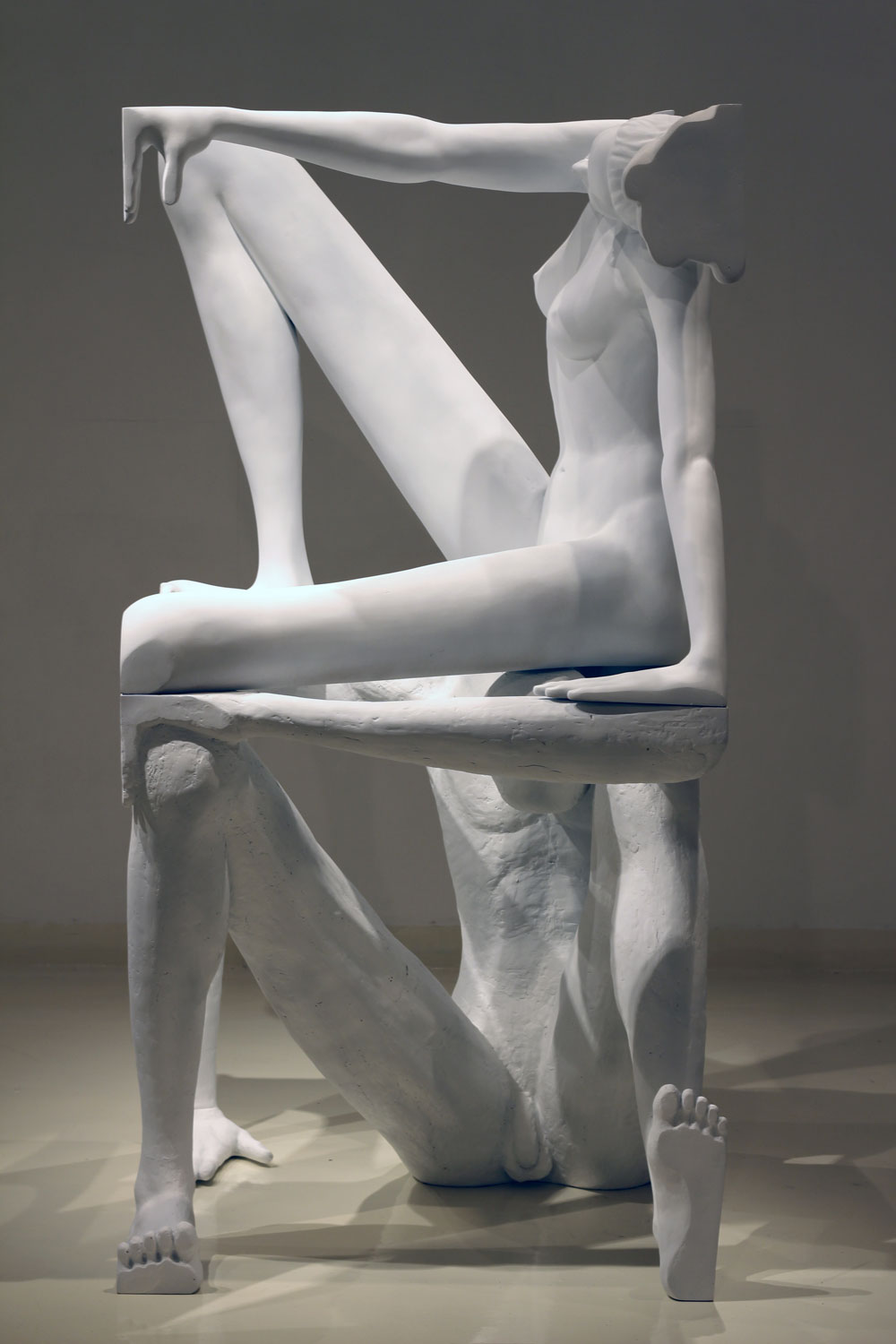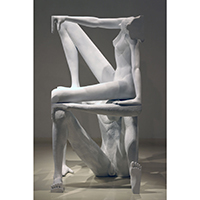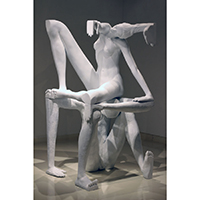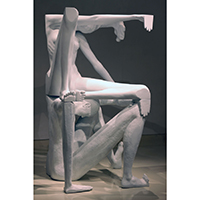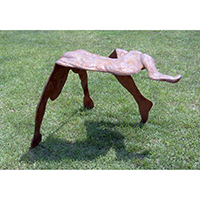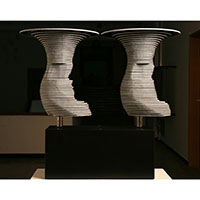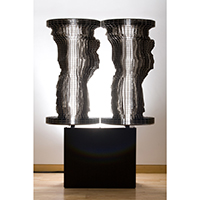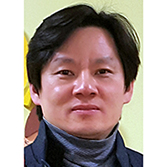
Ki-Hoon Kim, Savina Museum of Contemporary Art
Birth
1968, Seoul
Genre
Sculpture, Installation
Homepage
Curved Four-Dimensional Sculptures by Kim Kihoon
Kim Kihoon’s sculptures borrow from the format of “the movement of machines,” which is an aesthetic element of kinetic art in the context of art history, and show a close relation to the icons of contemporary society while simultaneously combining engineering knowledge and a sense of imagination based on analogue sensibilities. In the corner of his Yongin-based workshop are scattered discarded car parts, tools, and ingenious self-designed machines produced for his works, which made me hope that this visit to his workshop might possibly unravel the mystery of his works. Faced with his inscrutable artistry, however, I found myself unable to shake off a certain sense of tension! In fact, his works appear to move in a simple way, but drew me further into a labyrinthine mystery the longer I gazed at them. It was as if their slow movements and refusal to give an easy answer were intended to make a mockery of our instant perspective, which has become accustomed to today’s visual devices that instantly create spectacles using state-of-the-art technologies. Enlightenment eludes the impatient. Take a long while, look and think. This is the mantra his sculptures chant as they stoically move in silence.
Visual hegemony hidden in moving figures
Consisting of two lumps with indescribable figures that slowly rotate, this particular sculpture is titled Sunev. After a few rotations, the piece clearly reveals the figure of Venus turning 360 degrees. This is not an illusion. It is an image created in the air as the two adjacent pieces rotate; the image was there in that space from the very start, turning along with the sculpture. It was just that our cognitive senses failed to perceive the figure. Art education pales before this realization, since it focuses on analyzing proportion or beauty in the form. Meanwhile, Kim Kihoon’s works are based on classical theories of visual perception such as experientialism and Gestalt psychology1), as well as the Op art style, which works with optical illusions and change of perception. In addition, he actively incorporates “vision” and “modernity,” which connote strong social, historical and political relations.
--------------------------------------------------------------
1)In experientialism, ordinary visual perception is claimed to be synesthetic combined with other senses, and a complex process established by experience and memory, as opposed to the direct visual recognition of an object. Meanwhile, Gestalt psychology emerged in the 20th century to question and challenge such assertions. Gestalt refers to a unified structure that constitutes objects of perception, which is differentiated from the background; the space in which the perception of gestalt takes place can be understood as a structure of the global figure/background. Gestalt psychology emphasizes the active role of the mind in perception.
As is generally known, ordinary vision is not to purely look at things, but is instead deeply influenced by the function of cultural media. We choose to see what we see, and depending on this act of selection, we come to hold distorted or contrasting perspectives. His work, OX, consists of two plates engraved with signs of different meanings, which are made to cross and interfere with each other through the use of a car engine and a reduced motor to create distorted images. In this piece, the artist points out that ordinary visual perception is not to directly capture the object, but rather a complex process created by experience and memory. As such, the accidental images produced by mechanical movements in his works demonstrate that visual experience is not something that is direct and universal, but instead social and historical, resulting from relationships with other people and affected by certain knowledge or conventions.
Another work from his early years, Background, manifests the relationship between “vision” and “modernity” from another perspective. Since the work also borrowed its formal aspect from Op art, at a glance it seems easy to understand due to its familiar figure and background structure. An acrylic panel marked with repetitive elliptical lines is made to move from side to side, creating a phenomenon that makes the steel ruler erected in the center of the steel frame to appear curved, which is an optical illusion caused by perceptual physiology. The artist allows the viewers who are instantly captivated in visual revelry to be able to read into the multilayered meanings of the social context which is the metaphor behind the striped plate, by tearing and gluing 10,000-won bills in an elliptical pattern. Thus, visual amusement leads to a reflection on the visual culture of modernity, which in turn leads into a reflection on ourselves. Our vision, which fails to recognize the reality of the figure of Venus created in the air, or the gaze of modern mankind, which distorts another individual’s character based on our viewpoint or background; all such things are the result of what is learned from culture, or the result of what individuals learn about how to look at objects. As such, our way of looking at things, which is taken for granted and considered a given, is closely related to relationships of power and control, while Kim Kihoon acutely criticizes this visual hegemony through his works.
Measurable happiness and measurement of the empty space
One of the elements that have often appeared in his kinetic sculptures is a graduated ruler. Is it the artist’s attempt to demonstrate as precisely as a ruler the distorted perception of modern mankind? The recent controversy on the internet over the issue of beauty caused by the Miss Korea beauty pageant resulted in the pageant’s screening committee reportedly attempting to dismiss suspicions using the expression “the beauty of uniqueness.” Today’s perspectives, however, are far too statisticized and quantified to recognize this kind of individuality. Another piece of Kim’s work, Measurement of the Empty Space, presents the figure of an anonymous head that rotates 360 degrees in the empty space between two structures enveloped in stacked rings of rulers, which resembles the aforementioned Venus figure. This work seems to starkly portray the prejudices and standards embedded deep within our minds.
If asked a multiple-choice question on what constitutes happiness in today’s egalitarian society, most contemporary people would choose material comfort. It has to be a well-being measurable in terms of objects and signs and exist as a measurable thing. Jean Baudrillard made the above remark on the myth of happiness in contemporary society in his book, Consumer Society, and added, “Happiness as total or inner enjoyment—that happiness independent of the signs which could manifest it to others and to those around us, the happiness which has no need of evidence—is therefore excluded from the outset from the consumer ideal in which happiness is, first and foremost, the demand for equality and must, accordingly, always signify with ‘regard’ to visible criteria.”2)
------------------------------------------------------------------
2)Baudrillard, Jean. Consumer Society. Translated by Lee Sang-ryul.Moonyebooks, 1991. p 53. (Original work published 1970)
In Moving Portrait, the face of King Sejong the Great of Joseon era on lengthwise strips of a 10,000-won bill is made to look as though he is laughing or crying using a reduced motor; this work portrays people in contemporary society, who cry or laugh because of “money,” which is the absolute standard for happiness in this capitalist world. Once regarded as the symbol of a man of virtue possessing a mettle, integrity, and character, which was the ideal aim of our ancestors, the bamboo sticks are bent and its leaves are shaken through the act of the audience turning a knob. As such, Kim Kihoon’s kinetic sculptures, which bend, curve, and transform standards, create four-dimensional images and respond to the viewers by asking whether we are ceaselessly measuring the circumference of empty space in a modern world where capital and body substitute mind and soul, and commodity fetishism prevails.
Cho Ju-hyun, Curator, Seoul Museum of Art (SeMa)






